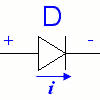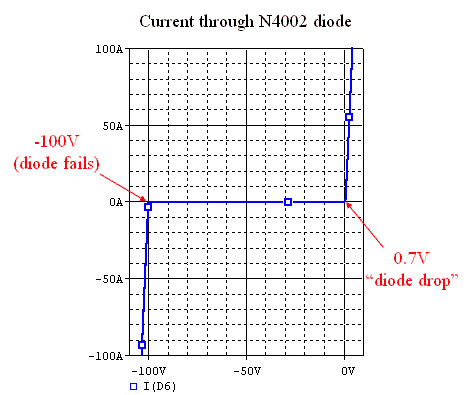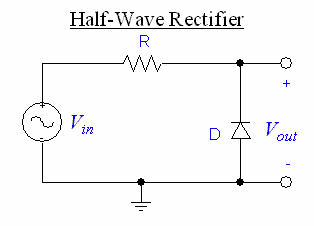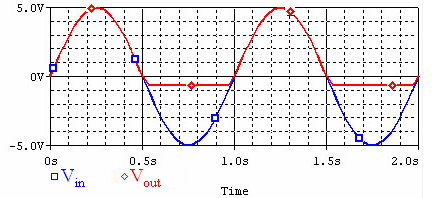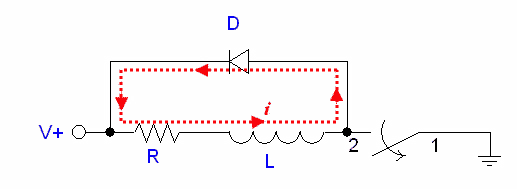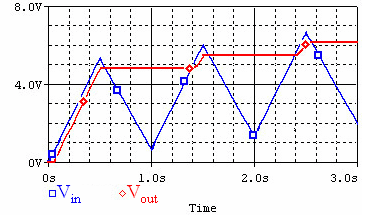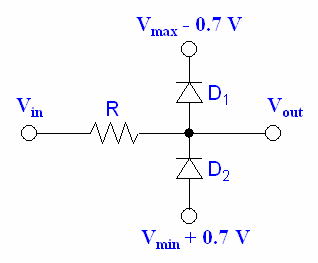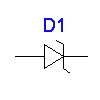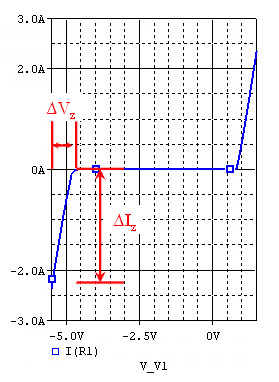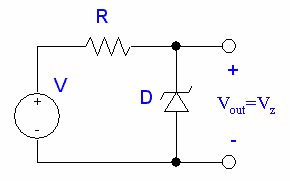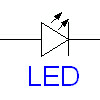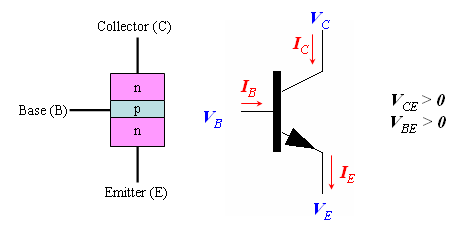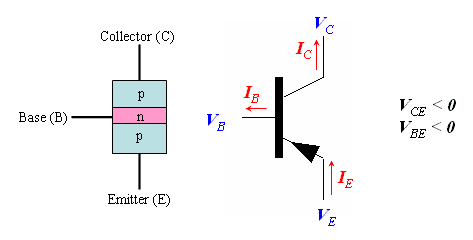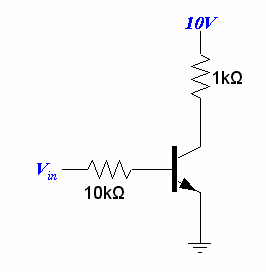Difference between revisions of "Diodes and Transistors"
| Line 19: | Line 19: | ||
====Flyback Diode==== |
====Flyback Diode==== |
||
An approximate model of a DC motor is a resistor and inductor in series. If there is a current <math>i</math> through the motor, and we suddenly break the circuit by opening a switch, for instance, there will be a spike in the voltage across the inductor. This is because the current has to instantly go to zero (there is no longer a path for it) |
An approximate model of a DC motor is a resistor and inductor in series. If there is a current <math>i</math> through the motor, and we suddenly break the circuit by opening a switch, for instance, there will be a spike in the voltage across the inductor. This is because the current has to instantly go to zero (there is no longer a path for it), and the voltage across the inductor is proportional to the rate of change of current, |
||
<math>v_L = L di/dt</math>. This may exhibit itself in a spark at the switch. A mechanical analog of this is trying to bring the velocity of a moving mass to zero, instantly. |
<math>v_L = L di/dt</math>. This may exhibit itself in a spark at the switch. A mechanical analog of this is trying to bring the velocity of a moving mass to zero, instantly. |
||
Revision as of 15:51, 21 June 2006
Diodes
We can take advantage of the properties of a p-n junction to make a diode, which is an electrical component that only allows current flow in one direction. A diode made of silicon needs about 0.7V across it in the forward direction (forward biased) in order to conduct. At a large negative voltage (reverse biased), the diode will fail and the current will force its way though. This is known as diode breakdown.
Applications of Diodes
Half-Wave Rectifier
A half-wave rectifier will cut off half of a sine wave, leaving only the positive or negative side.
The schematic for a simple rectifier:
The graph for half-wave rectifier:
Flyback Diode
An approximate model of a DC motor is a resistor and inductor in series. If there is a current through the motor, and we suddenly break the circuit by opening a switch, for instance, there will be a spike in the voltage across the inductor. This is because the current has to instantly go to zero (there is no longer a path for it), and the voltage across the inductor is proportional to the rate of change of current, . This may exhibit itself in a spark at the switch. A mechanical analog of this is trying to bring the velocity of a moving mass to zero, instantly.
To alleviate this problem, we can put a flyback diode across the motor terminals, as shown below:
This diode allows current to continue flowing through the motor, satisfying the inductor's "desire" to continue to allow current to flow. The energy in the inductor is dissipated over time by the resistance of the motor, and the current drops smoothly to zero. Note that no current flows through the diode when the switch is closed, as it is reverse biased. The flyback diode must be sufficiently large to carry the potentially large currents of the motor.
Question: If the voltage supply is +10V relative to ground and the diode drop is 0.7V, what is the voltage (relative to ground) at the terminal of the motor connected to the switch immediately after the switch is opened? (Remember, the voltage across an inductor can change discontinuously, but not the current, if there is any possible path for the current.)
Peak Detector
We can make a peak detector if we hook up our circuit like this:
The graph of the input and output voltages looks like this:
Each time the input voltage dips, the diode prevents the capacitor from draining.
There are two problems with this circuit: First, the voltage of the peak must be greater than the voltage drop, or we won't detect anything. Second, the circuit has a very low impedance, and the capacitor drains a lot of current. A better peak detector can be built with op-amps.
Voltage Clamp
A voltage clamp will limit the output voltage, which is useful when we need to protect circuits from high voltages.
In this ciruit, if exceeds , the diode will conduct and force the voltage to stay at . At lower voltages, the diode does not conduct, and the voltage is not affected.
Zener Diodes
Zener diodes have a low breakdown voltage, or zener voltage, and can allow reverse current to flow without being destroyed. A good zener diode can also maintain a fairly constant voltage over a large range of currents. The voltage-current graph of a zener diode looks like this:
Voltage Regulator
We can use a zener diode to build a voltage regulator like this:
is the reverse breakdown or zener voltage.
Even if the current through the diode fluctuates, the voltage will remain fairly stable. Choose a resistance R large enough such that the power specs of the zener diode are not exceeded, but not so large that it limits our current too much.
For example, if our diode has a zener voltage of 5V and can handle 1W, and our voltage source has a maximum voltage of 20V:
The largest amount of current our diode will ever have to handle is the current through the diode when there is no external load. Therefore:
This means that we need at least 75Ω to protect our diode. Keep in mind that we must meet the power ratings for our resistor as well.
Because current is flowing through the resistor and diode even when there is no load, power is being wasted. We can do better with voltage regulator chips like a 7805 chip (78xx for xx volts).
LEDs (Light Emitting Diode)
And LED is a type of diode that emits visible or infrared light proportional to the current passing through it (up to a maximum before it burns out).
Bipolar Junction Transistors (BJT)
There are two types of of BJTs; n-p-n and p-n-p:
npn
pnp
For the transistors, we have the following relationship for the voltages and curents:
Under normal operation, BE is forward biased, and CB is reverse biased.
BJTs have three regions of operation:
Cutoff: (no collector current)
Active: β (collector current is proportional to base current by factor β)
Saturated: ≈ (for npn); (maximum collector current)
Applications of BJTs
Common Emitter Circuit
In a common emitter circuit, the emitter of a transistor is grounded and an input voltage is applied at the base. An example common emitter circuit with a transistor (β=100) is drawn below:
If < 0.7V (same as the diode drop), the p-n junction is not forward biased and no will equal 0.
If > 0.7V, then
β
Now we will try to calculate how large has to be to saturate the transistor. When , the transistor becomes saturated. If the drop across the collector and emitter of the transistor is equal to 0.2V, then the drop across the resistor at the collector must equal 9.8V. Thus:
β
Then we find :
Ω
or greater.
cutoff: < 0.7V
active:0.7V < <1.68V
saturated:1.68V <
